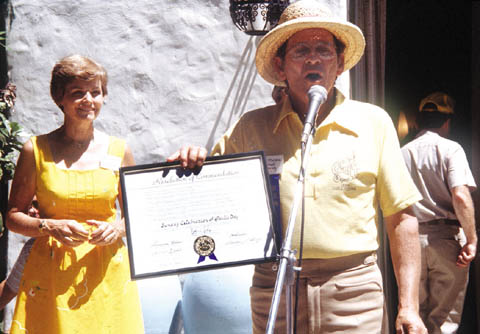
Gilroy might never have become known as
”
the Garlic Capital of the World
”
if Rudy Melone hadn’t happened upon a short newspaper
article.
Gilroy might never have become known as “the Garlic Capital of the World” if Rudy Melone hadn’t happened upon a short newspaper article. In mid-1978, Melone was perusing the San Francisco Chronicle when he came across a two-inch article about a garlic festival put on by the French town of Arleux.
“They called themselves the ‘garlic capital of the world,’ ” said Gloria Melone, his widow. “He asked me, ‘How could a little town call themselves that? Gilroy is the bigger garlic producer.’ ”
Rudy, at that time the president of Gavilan Community College, asked his wife what she thought about Gilroy putting on its own fest to celebrate the stinking rose. She thought it was an excellent idea, but she had questions about whether people would appreciate the concept. After all, garlic wasn’t a very glamourous crop. In the 1970s, people who liked garlic kept quiet about their passion because they didn’t want to be laughed at.
Rudy decided to try out the idea on the local Rotary Club to see their reaction. Among the members, he talked to Don Christopher, a major producer of garlic in the area, and local resident Val Filice. Rudy, Christopher and Filice did not know it at the time, but they were starting an institution that would put Gilroy in the culinary constellation.
Rudy wrote to the mayor of Arleux to find out how they ran their French festival. The mayor wrote back in French and said the main dish they serve was garlic soup. That was fine for Arleaux, which attracted about 80,000 people to its festival, but soup in the summer in California probably wasn’t the key ingredient to Gilroy’s festival success.
The mayor sent a mimeograph copy of Arleux’s festival program which gave Rudy a rough idea how to create Gilroy’s version of a garlic festival.
“He also sent us a 10-foot long garlic bread that stunk up my garage,” Gloria said with a laugh. “Talk to about coals to Newcastle!”
Rudy went ahead with his festival plans. A lot of local citizens didn’t want to get involve in the beginning, Gloria remembers. Some thought it was a crazy idea.
“And other people were asking, ‘What’s Melone going to get out of it?’ ” she said. “But truly what he wanted was to get money for the city.”
Rudy never made a penny for himself from the festival, she said.
Rudy had been requested by the local business people to ask for money from the city government to fund the Gilroy Chamber of Commerce, she said. But Rudy said the chamber shouldn’t be begging for money but making money on its on. And he thought a festival would be the way to bring in the green.
Rudy and Gloria Melone both understood the organizational structure of universities and colleges – both had their doctorates and Gloria worked as an administrator at San Jose State University. So, in organizing the festival’s charter, they came up with an idea based on academia.
People could volunteer for a few years, become a chair, then a co-chair, move on to the board of directors, and ultimately, they could serve as the president of the festival. The intention was to keep a flow of new people in new positions.
“You move up the ranks in other words,” she said. “Rudy felt very strongly that fresh ideas, fresh blood would stimulate creative thinking. So that not one person would own it, you don’t stay there forever.”
Another idea Rudy came up with that made the Garlic Festival a success was the distribution of profits. Volunteers would choose what non-profit organization they wanted the money to go to, and after all the bills were paid, the money was divided between the groups based on man-hours put in by their volunteer workers.
The first year, 1979, the festival took place in the dusty field in front of the Bloomfield Ranch near the intersection of U.S. 101 and Highway 25.
“The poster at the festival did not have a date because the man in charge of it thought it was going to be the first and the last,” Gloria said.
The festival organizers were shocked by how many people flocked to that inaugural festival. They thought they’d be lucky if they could get 5,000 garlic lovers to come. Instead, more than 15,000 people came in search of garlic.
The festival organizers hadn’t printed enough tickets, so volunteers had to collect the printed tickets from the gates and run back to the ticket booths to re-sell the tickets, she remembers.
Now, the country has all kinds of summer festivals focused on food. And the Gilroy Garlic Festival started the trend, Gloria said. So popular was the festival and successful as a money-maker that government employees from Washington came to Gilroy to interview Rudy, Gloria said. They wrote a pamphlet that has become a model for organizing food festivals.
Rudy served a second year as president of the festival in 1980.
He died in 1998 at the age of 73. Gloria lives in San Francisco now, but comes back every year to the festival he started.
She emphasized that Rudy always believed it was the army of volunteers that made the festival a success.
“It takes a lot of people,” she said. “Sure it took Rudy to think of the idea, but a lot of people in the community came forward to help. It would not be successful without those people and the volunteers. That’s the strengths of the festival. It’s priceless, their time and effort. You can’t buy that.”
This year, Gloria is scheduled to do a cooking demonstration around noon on Friday at the Festival’s culinary stage.









